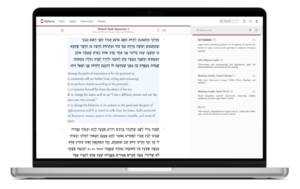(Press Release) For the first time ever, learners can experience a full digital, English translation of the Mishneh Torah interconnected with other Jewish texts, thanks to Sefaria, a non-profit organization that digitizes and freely shares Jewish texts in Hebrew and in translation. The Mishneh Torah, authored by Rambam (Maimonides) in the Medieval era, consists of fourteen books and is a major code of halakhah (observance of Jewish law). Learners can access it on sefaria.org and through the Sefaria iOS and Android apps.

“We are so excited for learners to dive into this rich text and share their reflections with each other and the world,” says Sara Wolkenfeld, Chief Learning Officer of Sefaria. “Sefaria learners show just how alive and relevant these texts continue to be. They wanted this translation so they can learn halakhah in deeply connected ways with others. The Mishneh Torah is one of Judaism’s foundational texts with layer upon layer of meaning and laws that people can grapple with.”
The translation was completed between 1986-2007 by Eliyahu Touger; Sefaria worked for several years on acquiring and putting up the translation. The new Mishneh Torah on Sefaria includes:
-
Complete English translation.
-
Extensive interlinking to the Tanakh (bible), Babylonian Talmud, and other works, providing connections that help with understanding the work and placing it in context.
-
Topic tagging so searches on Sefaria will surface references from the Mishneh Torah, adding this text to the resources available to learners as they research topics that interest them.
-
Several Hebrew commentaries.
In the Mishneh Torah’s introduction, Rambam writes, “Therefore, I have called this text Mishneh Torah [“the second to the Torah,” with the intent that] a person should first study the Written Law, and then study this text and comprehend the entire Oral Law from it, without having to study any other text between the two.” The Sefaria platform enables users to experience how the Mishneh Torah is connected to other texts, tracing the development of Jewish law from the Tanakh, to the Talmud, and then to Rambam, and from Rambam to Shulkhan Arukh.
“We want the text to invite the user in, as we hope all of our texts do,” Wolkenfeld continues. “The Mishneh Torah singularly reflects both the depth and breadth of Jewish teachings and laws. For the Jewish people, our texts are our collective inheritance. They belong to everyone and we want them to be available to everyone, in the public domain or with creative commons licenses.”
Sefaria is the digital home to 3,000 years of Jewish texts, providing access to these texts at no cost, along with translations and commentaries so that everyone can participate in the ongoing process of studying, interpreting, and creating Torah. Since 2013, Sefaria has been developing its library and user-friendly software that enables users to more easily access and deepen their understanding of the ever-growing Jewish canon. Texts are linked to one another in a sidebar that displays references or other connections so that users can seamlessly move between different sources representing thousands of years of Jewish scholarship. The software also allows users to create source sheets — sharable user-generated content that incorporates texts from Sefaria’s library with their own commentary and additional media. Sefaria is used by more than 500,000 people each month, including students, educators, scholars, and others.
The Mishneh Torah English translation on Sefaria is dedicated in memory of Irving Montak (z’’l).
*
Preceding provided by Sefaria